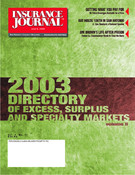 Coverage for technology torts—”techno-torts” or “cybertorts”—is limited under the standard general liability policy. “Coverage A” of the standard CGL form requires bodily injury or property damage, and may not extend to loss of data, business interruption or other intangible loss. In addition, Coverage A is limited to damage caused by an “occurrence”—an unexpected or unintended event—and thus precludes coverage for most intentional torts.
Coverage for technology torts—”techno-torts” or “cybertorts”—is limited under the standard general liability policy. “Coverage A” of the standard CGL form requires bodily injury or property damage, and may not extend to loss of data, business interruption or other intangible loss. In addition, Coverage A is limited to damage caused by an “occurrence”—an unexpected or unintended event—and thus precludes coverage for most intentional torts.
“Coverage B” of the standard CGL policy encompasses some intellectual property torts, but is still limited. This coverage—designed for personal and advertising injury—is limited to certain enumerated offenses, which include defamation and invasion of privacy, but do not include many intellectual property torts. Patent infringement, for example, is not itemized, leading many courts to conclude it is not covered. The limitation of advertising injury to offenses committed in the course of advertising activity further restricts coverage. Many torts committed in the context of design or manufacturing, such as copyright infringement or misappropriation of trade secrets, will not involve advertising activity.
As technology advances, and even small businesses face increasing exposure to claims of infringement and unfair competition, the insurance industry has responded with “new” forms and policies. While “basic” coverage has become more restrictive, many companies offer expanded coverage by endorsement, or offer products specifically tailored for new exposures created, largely, by expanded use of the Internet. Unique coverage issues are likely to arise from the differences between these new products and standard coverage.
Many technology torts involve infringement—of trademark, trade dress, domain name, copyright, etc. Infringement of another’s intellectual property rights typically involves intentional conduct, and is unlikely to constitute an “occurrence.” Even those torts that can be committed negligently or without specific knowledge of the other’s rights may involve a mistake, but are unlikely to involve an “accident.” And, economic damage is usually not considered “property damage.” Debate has arisen over computer and technology related losses, as to whether loss or damaged data is tangible—and could therefore constitute property damage—or is merely intangible loss of information. Exclusions for damage to the insured’s own work or product may further restrict coverage for system engineers and consultants, Web designers, software developers, and others in the technology business.
Under standard liability policies, most intellectual property coverage is found under Coverage B. Older forms distinguish between personal injury and advertising injury, while newer forms combine the two. Under either version, many of the torts involve a required nexus to advertising activity, raising the issue of when Web sites or e-mail messages are, or are not, advertising.
The new policies are not uniform and take myriad approaches to re-defining coverage. While many of the offenses covered are the same or similar to those covered by, or implicitly covered by, the general liability policy, others are beyond the scope of Coverage B. For instance, coverage is sometimes specifically extended to patent infringement. In addition, plagiarism may be included. Coverage is typically not limited to advertising activity, but involves multi-media activity. Thus, coverage may be afforded for a far broader range of intellectual property torts.
Policies may include coverage for media liability, professional services, liability for security breaches, cyber-extortion or asset and loss of income. Rather than specifying particular offenses, the insuring agreement of many such forms broadly extends to wrongful acts, including infringement torts, resulting from Internet content. Accordingly, claims of meta-tag or domain name infringement, as well as claims of defamation, disparagement or copyright infringement, should be covered. Because Internet media is usually broadly defined, claims of patent infringement arising from Internet usage, such as the claims arising from Web site checkout procedures, may also be covered. The inclusion of coverage for content-based liability arising from acts of third parties in some policies is also a significant expansion upon traditional general liability coverage.
Professional services liability coverage typically extends to Internet technology services or Internet professional services. Security coverage extends to a failure of security in the insured’s computer system, including the failure of hardware, software or firmware designed to prevent computer attacks, unauthorized access, unauthorized use, disclosure of confidential or private information, or the transmission of a malicious code. Coverage for extortion may extend to money paid in response to a threat, including the introduction or transmission of a virus. In addition, first party coverage is available for damage to information assets and Internet business interruption, resulting from a failure of security in the insured’s computer system. Coverage for breach of security may be offered for external attacks, internal and external attacks, and for specified portions of the computer network, or an entire network worldwide.
Typical exclusions include antitrust or restraint of trade claims—neither of which is specifically referenced in the CGL form. Damages are not limited to “property damage,” but are frequently limited by exclusions for penalties, fines, and trebling of damages or acts of knowing infringement. In addition, coverage may be excluded for suits brought by or on behalf of federal, state or local government agencies, or other licensing organizations in their regulatory, quasi-regulatory or official capacity.
In weighing the various liability coverages available, careful attention should be paid to how damages are defined, and what types of damages will be covered, as well as to the issue of whether attorney’s fees will reduce the limits of liability. Typically, claims for purely injunctive relief will not be covered, as there is no claim for “damages.” Where injunctive relief is sought in conjunction with other damages, a duty to defend may still exist. Careful attention should be paid to the question of limits, and whether defense expenses reduce the policy limits. Given the magnitude of the defense expense in most infringement cases, the depletion of limits by payment of a defense expense can significantly reduce the indemnity protection afforded under the policy. And, ever more frequently, policies provide for resolution of disputes through mediation or arbitration, rather than litigation.
Depending on the language of the policy, awards of plaintiffs’ attorneys’ fees, or statutory multiple damages, may not be covered. Some of the policies expressly exclude multiple damages. Others, while not specifically addressing multiple damages, include exclusions for malicious or dishonest conduct, or for damages expected or intended by the insured. Thus, where attorneys’ fees are based on a finding of malicious, fraudulent, deliberate or willful conduct, the attorneys’ fees award may not be covered. Similarly, statutory damages based on a willful or knowing infringement may not be covered. Criminal penalties are also excluded under most policies. Where, for example, willful infringement of a copyright leads to criminal penalties under 17 U.S.C. §506, and a monetary penalty is imposed, it is probable that no coverage is afforded. And, if conduct, such as “spamming,” is criminalized, even civil liability will likely be excluded.
These new coverages—tracking new tort exposures—provide untested ground for coverage disputes as to which existing law and policy construction provides only a partial roadmap.
Was this article valuable?
Here are more articles you may enjoy.


 LA Fires and US Severe Convective Storms Drive Insured Losses of $107B in 2025
LA Fires and US Severe Convective Storms Drive Insured Losses of $107B in 2025  UPS Ripped Off Seasonal Workers With Unfair Pay Practices, Lawsuit Alleges
UPS Ripped Off Seasonal Workers With Unfair Pay Practices, Lawsuit Alleges  Cessna Jet Tied to Nascar Driver Greg Biffle Crashes in North Carolina
Cessna Jet Tied to Nascar Driver Greg Biffle Crashes in North Carolina  McKinsey Plots Thousands of Job Cuts in Slowdown for Consulting Industry
McKinsey Plots Thousands of Job Cuts in Slowdown for Consulting Industry 


